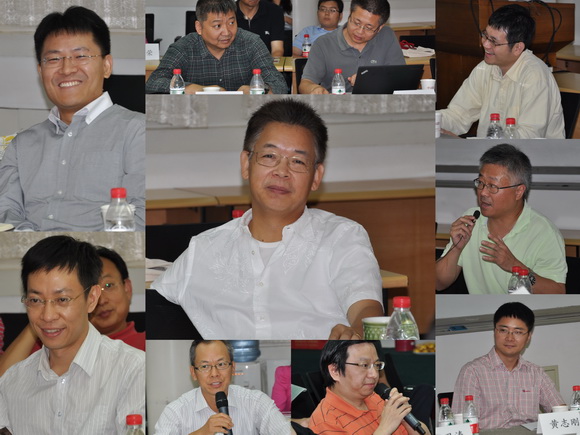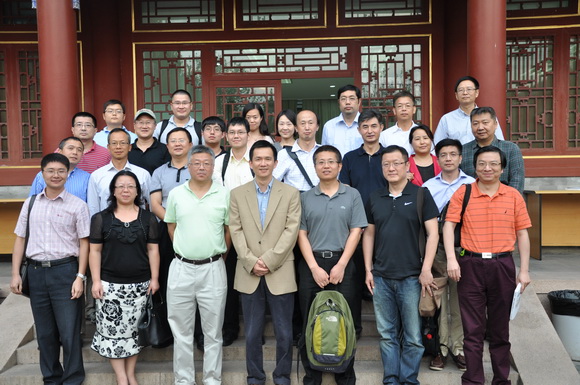

RMB exchange rate movements are full of uncertainty due to the possibility of Federal Reserve Board’s quantitative easing exit, the risk of a hard landing in China, and the People's Bank of China’s intention to accelerate capital opening. A roundtable forum of the financial alumni and the National School of Development (NSD) of Peking University on “Future RMB Exchange Rate” was held in the Long Run Park on the afternoon of September 15, 2013. It is a preliminary activity of the NSD Policy Talk initiated to celebrate NSD’s 20th anniversary and enhance its think tank.
More than forty alumni attended the conference chaired by Huang Yiping from NSD, among whom were Wei Zhichao from China Investment Securities, Huang Zhigang from Central University of Finance, Xu Sitao from the Economist, and Xu Jianguo and Yu Miaojie from NSD. In the session from 14:30 to 17:30, keynote speeches were delivered and sparked enthusiastic live discussions with ad hoc reviews or independent opinions. Here are some representative views, with the name of speakers in the internal discussion omitted deliberately. It should be noted that the views between the speakers may be logically inconsistent.
Right time to liberalize the floating range of exchange rate
As far as China is concerned, the improvement of the international balance of payments is structural, rather than periodic, so the RMB exchange rate is towards equilibrium value as the payments tend to balance. In equilibrium exchange rate, the relaxation of exchange rate controls will not cause large fluctuations, posing a favorable timing to expand the floating range. Although the U.S. QE exit is likely to lead to capital outflows from emerging markets, the Chinese capital controls are still valid and the capital flow is under control. There is no need to worry that shocks.
Taiwan's experience with a unique reference value
Mainland China and China Taiwan share many similarities in the development models. In terms of the development stage, the current account to GDP ratio in mainland China in recent years is very similar to that of Taiwan in 1990, with the peaks arriving in 2007 and 1989 respectively, followed by subsequent decline.
Judging from the exchange rate regime, the exchange rate was gradually released from control in China Taiwan, and there were no massive fluctuations. Its road and experience are worth considering, but should be treated differently in certain key points.
In the short run, the exchange rate theoretically should be devalued and is to be devalued
Generally, discussions always focus on what it should be in theory and what it would be in fact. In theory, RMB should slightly depreciate under the pressure of restructuring and retrenchment in current domestic macroeconomic context. In tendency, RMB will depreciate in reality in view of the QE exit impact on emerging markets, short-to medium-term inflationary pressures, and the relatively strong dollar.
Tendency to balance does not mean reform stagnation acceptable
Exchange rate distortions are not serious as before as the exchange rate increases. However, more importantly, the exchange rate formation mechanism remains distorted. For enterprises, the exchange rate is still an exogenous variable and decisions are made in the context of given exchange rate. Trade, consumption, and economic structure will be subject to the impact of the exogenous exchange rate. Once the exchange rate is endogenous, the income distribution, industrial structure and consumption structure will change, which is worth considering. In comparison, Germany kicked off the currency reform earlier than Japan, so the entire economic structure and efficiency are better than the Japanese. South Korea presented the best performance after the Asian financial crisis, which is also benefited from the floating management from 1964 onwards.
Appreciation-forced exchange rate reform
Following the RMB appreciation, the increase of imported products exerts a "forced" pressure on domestic enterprises. Like the case of joining in the WTO in 2001, openness can force domestic reforms difficult to be carried out, and also urge enterprises to improve the efficiency. In addition, the increase of intermediate imports after the RMB appreciation may have exerted an amplified effect on domestic production, and will probably improve labor productivity.
RMB in the third echelon in the international arena
RMB should be international and have a currency status matched with the real economy. However, objectively speaking, RMB is only in the third tier, or even the fourth among the international currencies currently, after the first tier of the U.S. dollar and the second tier of pound sterling, Japanese yen, and Swiss franc. To become a truly great power, the RMB internationalization is inevitable. In order to push ahead RMB’s international progress, bilateral currency swap can be increased, not necessarily with the developed countries, but with developing countries more realistically.
Japan’s experience in yen internationalization worth reference
A large number of interest-free loans issued by Japan after World War II became disguised usury with the appreciation of the yen. In this regard, China suffered misfortune early after the reform and opening up. It is also related with the price reform in the 1980s.
Africa is the major overseas market of RMB to drive the internationalization of RMB through foreign investment. In this respect, China can learn from the U.S to abandon high yields. It is difficult to reach the high return overseas as 8% at home and likely to drain the project pond and fail to be accepted by others.
RMB internationalization is premature.
RMB internationalization is not only an economic issue. It also involves the political system and international recognition which lays an important foundation for sovereign currency internationalization. At the moment, the country has not been well in both aspects.
China lags far behind the U.S. in the economic basis, and has not yet received a high degree of international recognition of the values ??and the political system. It is difficult to accept the Chinese government-oriented economy and the single-party system among the world's major economies which adopt the market-oriented economy and democracy. In fact, the top priority currently is neither the international recognition nor the internationalization of RMB, but to better the work at home. Efforts should be made to straighten out the domestic issues before advancing the progress of internationalization.
Inadequate internal opening up is the core problem currently.
As far as China is concerned, the exchange rate should serve for the domestic economic development. However, it remains inadequate in the instrumental services, judging from the current domestic economy, and therefore should be adjusted in a quicker pace. For example, we should quickly change the output of commodities to the output of capital. Up to the current stage of economic development, a lot of issues will arise if no adjustment to the exchange rate. Japan is a precedent.
With respect to the direction of adjustment, depreciation is not the necessary way, and we should first promote the exchange rate reform-driven domestic industrial restructuring. We lost a very opportunity in 2008 and the four trillion was used more to support the original industrial structure.
From a strategic point of view, the most urgent in the whole financial reform lies in the internal opening up, rather than the external financial opening.
In the exchange rate reform, the external financial opening is acceptable and needs to move forward steadily, but the internal opening is not enough and should be accelerated.
Corporate management restricts foreign investment and internationalization
The internationalization of RMB should keep pace with the internationalization of enterprises. In this regard, the most successful case is probably Huawei, which is largely due to the superb management, rather than the state support. There are many state-sponsored enterprises, but few succeed in the international road.
In the internationalization of enterprises, state-owned enterprises have a very low management level, while private enterprises are small and far from able to digest the three trillion foreign exchange reserves.
Why foreign direct investment income is low?
Why China’s FDI income is low?
First, state-owned enterprises which account for about 70% of the foreign investment do not fully pursue yield, while private enterprises which take up a limited proportion lack funds and often miss the optimal opportunities because of the drag in government approval.
Second, resource-based industries which account for FDI’s 40% have a long industrial cycle, so the cycle of return is extended.
Third, enterprises have inadequate experience in overseas investment, on average about five or six years of experience, which are far from sufficient to understand the local rules of law and market rules, let alone trade unions and customs.
In the absence of technologies, brands, and management experience, the Chinese enterprises go out to introduce technologies, attract talents, and learn management, more than to pursue the rate of return on investment only.
After the conference, NSD Dean Yao Yang posed for group pictures and had dinner with guests in the Longrun Hall in Shao Yuan. Experts also discussed preliminarily the financial alumni groups and the possibilities for further cooperation with NSD.
